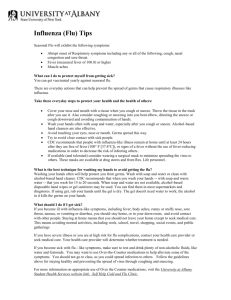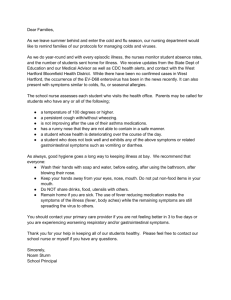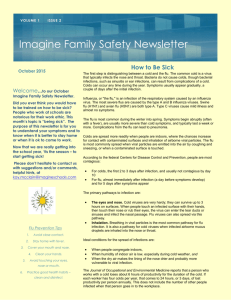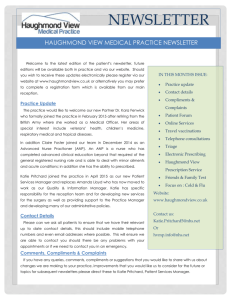Keeping Healthy (Treating Cold/Flu & Fighting Germs)
advertisement
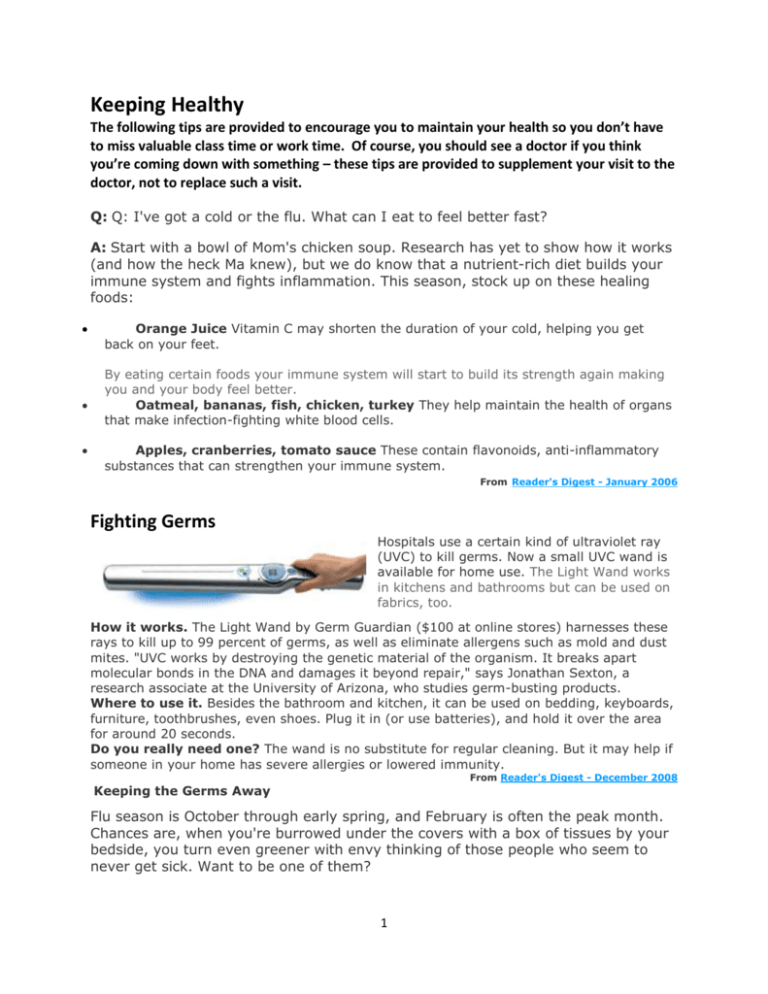
Keeping Healthy The following tips are provided to encourage you to maintain your health so you don’t have to miss valuable class time or work time. Of course, you should see a doctor if you think you’re coming down with something – these tips are provided to supplement your visit to the doctor, not to replace such a visit. Q: Q: I've got a cold or the flu. What can I eat to feel better fast? A: Start with a bowl of Mom's chicken soup. Research has yet to show how it works (and how the heck Ma knew), but we do know that a nutrient-rich diet builds your immune system and fights inflammation. This season, stock up on these healing foods: Orange Juice Vitamin C may shorten the duration of your cold, helping you get back on your feet. By eating certain foods your immune system will start to build its strength again making you and your body feel better. Oatmeal, bananas, fish, chicken, turkey They help maintain the health of organs that make infection-fighting white blood cells. Apples, cranberries, tomato sauce These contain flavonoids, anti-inflammatory substances that can strengthen your immune system. From Reader's Digest - January 2006 Fighting Germs Hospitals use a certain kind of ultraviolet ray (UVC) to kill germs. Now a small UVC wand is available for home use. The Light Wand works in kitchens and bathrooms but can be used on fabrics, too. How it works. The Light Wand by Germ Guardian ($100 at online stores) harnesses these rays to kill up to 99 percent of germs, as well as eliminate allergens such as mold and dust mites. "UVC works by destroying the genetic material of the organism. It breaks apart molecular bonds in the DNA and damages it beyond repair," says Jonathan Sexton, a research associate at the University of Arizona, who studies germ-busting products. Where to use it. Besides the bathroom and kitchen, it can be used on bedding, keyboards, furniture, toothbrushes, even shoes. Plug it in (or use batteries), and hold it over the area for around 20 seconds. Do you really need one? The wand is no substitute for regular cleaning. But it may help if someone in your home has severe allergies or lowered immunity. From Reader's Digest - December 2008 Keeping the Germs Away Flu season is October through early spring, and February is often the peak month. Chances are, when you're burrowed under the covers with a box of tissues by your bedside, you turn even greener with envy thinking of those people who seem to never get sick. Want to be one of them? 1 We can't promise you'll never get hit with another cold or suffer another bout of the flu, but you can increase your odds of staying well with these strategies. If you do get sick, we've also included some tips for getting better faster. While colds won't kill you, they can weaken your immune system to the point that other, more serious, germs can take hold in your body. Just think how many times your cold turned into bronchitis or a sinus infection. And given that the average American adult suffers two to three colds a year, that's a lot of opportunities for serious illness -- and just as many to prevent one! There's even more incentive to prevent the flu: Every year in the United States about 200,000 people are hospitalized and 36,000 die from the flu or its complications. 1. Wash your hands and wash them often. The Naval Health Research Center conducted a study of 40,000 recruits who were ordered to wash their hands five times a day. The recruits cut their incidence of respiratory illnesses by 45 percent. 2. Wash your hands twice every time you wash them. When Columbia University researchers looked for germs on volunteers' hands, they found one handwashing had little effect, even when using antibacterial soap. So wash twice if you're serious about fending off colds. 3. Use this hand-drying strategy in public restrooms. Studies find a shockingly large percentage of people fail to wash their hands after using a public restroom. And every single one of them touches the door handle on the way out. So after washing your hands, use a paper towel to turn off the faucet. Use another paper towel to dry your hands, then open the door with that paper towel as a barrier between you and the handle. It sounds nuts, but it's an actual recommendation from the Centers for Disease Control to protect you from infectious diseases like cold and flu. 4. Carry hand sanitizer with you. Colds are typically passed not from coughing or kissing (although those are two modes of transmission) but from hand-to-hand or hand-to-object contact, since most cold viruses can live for hours on objects. You then put your hand in or near your mouth or nose, and voilà! You're sick. Carry hand sanitizer gel or sanitizing towelettes with you and you can clean your hands anytime, even if the closest water supply is 100 miles away. It works. One study of absenteeism due to infection in elementary schools found schools using the gel sanitizer had absentee rates from infection nearly 20 percent lower than those using other hand-cleaning methods. 5. Use your knuckle to rub your eyes. It's less likely to be contaminated with viruses than your fingertip. This is particularly important given that the eye provides a perfect entry point for germs, and the average person rubs his eyes or nose or scratches his face 20-50 times a day, notes Jordan Rubin, Ph.D., author of the book The Maker's Diet. 6. Run your toothbrush through the microwave on high for 10 seconds to kill germs that can cause colds and other illnesses. You think it gets your teeth clean -- and it does. But once you're done brushing, your toothbrush is a breeding 2 ground for germs. Sterilize it in the microwave before you use it, or store it in hydrogen peroxide (rinse well before using), or simply replace it every month when you change the page on your calendar and after you've had a cold. Prevention Is Key 7. Get a flu shot every fall. The Centers for Disease Control recommends flu shots for anyone 50 years old or older, residents of long-term care facilities, people of any age who have chronic medical problems (heart or lung disease, asthma, diabetes, etc.), pregnant women, and people whose immune systems have been weakened (by cancer, AIDS, or other causes). Also, people who work or live with a high-risk person should get a flu shot so they don't spread the flu. Of course, anyone who just wants to avoid the flu should also get one. Hate shots? Ask for the nasal spray vaccine. 8. Stop blaming yourself when things go wrong at work. Believe it or not, blaming yourself makes you more likely to catch a cold! At least, that's what researchers found when they studied more than 200 workers over three months. Even those who had control over their work were more likely to begin sneezing if they lacked confidence or tended to blame themselves when things went wrong. Researchers expect such attitudes make people more stressed on the job, and stress, as you know, can challenge your immune system. 9. Put a box of tissues wherever people sit. Come October, buy a 6- or 12pack of tissue boxes and strategically place them around the house, your workplace, your car. Don't let aesthetics thwart you. You need tissues widely available so that anyone who has to cough or sneeze or blow his nose will do so in the way least likely to spread germs. 10. Leave the windows in your house open a crack in winter.Not all of them, but one or two in the rooms in which you spend the most time. This is particularly important if you live in a newer home, where fresh circulating air has been the victim of energy efficiency. A bit of fresh air will do wonders for chasing out germs. 11. Lower the heat in your house 5 degrees. The dry air of an overheated home provides the perfect environment for cold viruses to thrive. And when your mucous membranes (i.e., nose, mouth, and tonsils) dry out, they can't trap those germs very well. Lowering the temperature and using a room humidifier helps maintain a healthier level of humidity in the winter. 12. Speaking of which, buy a hygrometer. These little tools measure humidity. You want your home to measure around 50 percent. A consistent measure higher than 60 percent means mold and mildew may start to set in your walls, fabrics, and kitchen; lower than 40 percent and the dry air makes you more susceptible to germs. 13. Sit in a sauna once a week. Why? Because an Austrian study published in 1990 found that volunteers who frequently used a sauna had half the rate of colds 3 during the six-month study period than those who didn't use a sauna at all. It's possible that the hot air you inhale kills cold viruses. Most gyms have saunas these days. 14. Inhale air from your blow-dryer. It sounds nuts, we know. But one study conducted at Harvard Hospital in England found that people who breathed heated air had half the cold symptoms of people who inhaled air at room temperature. Set the dryer on warm, not hot, and hold it at least 18 inches from your face. Breathe in the air through your nose for as long as you can -- 20 minutes is best. 15. Take a garlic supplement every day. When 146 volunteers received either one garlic supplement a day or a placebo for 12 weeks between November and February, those taking the garlic were not only less likely to get a cold, but if they did catch one, their symptoms were less intense and they recovered faster. Sneeze Brigade 16. Eat a container of yogurt every day. A study from the University of California-Davis found that people who ate one cup of yogurt -- whether live culture or pasteurized -- had 25 percent fewer colds than non-yogurt eaters. Start your yogurt eating in the summer to build up your immunity before cold and flu season starts. 17. Once a day, sit in a quiet, dim room, close your eyes, and focus on one word. You're meditating, a proven way to reduce stress. And stress, studies find, increases your susceptibility to colds. In fact, stressed people have up to twice the number of colds as non-stressed people. 18. Scrub under your fingernails every night. They're a great hiding place for germs. 19. Change or wash your hand towels every three or four daysduring cold and flu season. When you wash them, use hot water in order to kill the germs. 20. At the very first hint of a cold, launch the following preventive blitz. Here's how: Suck on a zinc lozenge until it melts away. Then suck another every two waking hours. Or use a zinc-based nasal spray such as Zicam. Take one 250-milligram capsule of the herb astragalus twice a day until you are better. Cook up a pot of chicken soup. Roast garlic in the oven (drizzle whole clove with olive oil, wrap in tinfoil, roast for an hour at 400°F), then spread the soft garlic on toast and eat. Studies find that all either reduce the length of time you suffer with a cold or help 4 prevent a full-blown cold from occurring. 21. Wipe your nose -- don't blow. Your cold won't hang around as long, according to a University of Virginia study. Turns out that the force of blowing not only sends the gunk out of your nose into a tissue, but propels some back into your sinuses. And, in case you're curious, they discovered this using dye and X rays. If you need to blow, blow gently, and blow one nostril at a time. 22. Sneeze and cough into your arm or a tissue. Whoever taught us to cover our mouths when we cough or sneeze got it wrong. That just puts the germs right on our hands, where you can spread them to objects -- and other people. Instead, hold the crook of your elbow over your mouth and nose when you sneeze or cough if a tissue isn't handy. It's pretty rare that you shake someone's elbow or scratch your eye with an elbow, after all. 23. Don't pressure your doctor for antibiotics. Colds and flu (along with most common infections) are caused by viruses, so antibiotics -- designed to kill bacteria -- won't do a thing. They can hurt, however, by killing off the friendly bacteria that are part of our immune defenses. If you've used antibiotics a lot lately, consider a course of probiotics -- replacement troops for friendly bacteria. From Stealth Health Sneeze Brigade 16. Eat a container of yogurt every day. A study from the University of California-Davis found that people who ate one cup of yogurt -- whether live culture or pasteurized -- had 25 percent fewer colds than non-yogurt eaters. Start your yogurt eating in the summer to build up your immunity before cold and flu season starts. 17. Once a day, sit in a quiet, dim room, close your eyes, and focus on one word. You're meditating, a proven way to reduce stress. And stress, studies find, increases your susceptibility to colds. In fact, stressed people have up to twice the number of colds as non-stressed people. 18. Scrub under your fingernails every night. They're a great hiding place for germs. 19. Change or wash your hand towels every three or four daysduring cold and flu season. When you wash them, use hot water in order to kill the germs. 20. At the very first hint of a cold, launch the following preventive blitz. Here's how: Suck on a zinc lozenge until it melts away. Then suck another every two waking hours. Or use a zinc-based nasal spray such as Zicam. Take one 250-milligram capsule of the herb astragalus twice a day until you are better. 5 Cook up a pot of chicken soup. Roast garlic in the oven (drizzle whole clove with olive oil, wrap in tinfoil, roast for an hour at 400°F), then spread the soft garlic on toast and eat. Studies find that all either reduce the length of time you suffer with a cold or help prevent a full-blown cold from occurring. 21. Wipe your nose -- don't blow. Your cold won't hang around as long, according to a University of Virginia study. Turns out that the force of blowing not only sends the gunk out of your nose into a tissue, but propels some back into your sinuses. And, in case you're curious, they discovered this using dye and X rays. If you need to blow, blow gently, and blow one nostril at a time. 22. Sneeze and cough into your arm or a tissue. Whoever taught us to cover our mouths when we cough or sneeze got it wrong. That just puts the germs right on our hands, where you can spread them to objects -- and other people. Instead, hold the crook of your elbow over your mouth and nose when you sneeze or cough if a tissue isn't handy. It's pretty rare that you shake someone's elbow or scratch your eye with an elbow, after all. 23. Don't pressure your doctor for antibiotics. Colds and flu (along with most common infections) are caused by viruses, so antibiotics -- designed to kill bacteria -- won't do a thing. They can hurt, however, by killing off the friendly bacteria that are part of our immune defenses. If you've used antibiotics a lot lately, consider a course of probiotics -- replacement troops for friendly bacteria. From Stealth Health Staying Safe and Healthy in a Crowd Better Safe Than Sorry You're seated in a venue with a thousand other people. Which do you feel more threatened by: a fire, or a stranger sneezing on you? Chances are, most of us aren't very concerned about either. Which is an acceptable attitude to have -- both pose relatively minor health risks. But they pose risks nonetheless. And with a little more mindfulness you can better protect your health and safety in the rare case that something goes wrong at the concert hall or football game. We're not suggesting you avoid crowds. Just be sure to follow these tips to keep yourself and your loved ones safe and healthy while you're out living life to the fullest. 1. Keep your hands in your pockets. Remember the golden equation for getting sick: Germ gets on hands, hands touch face, germ enters body, you get sick. Where there are crowds, there are germs -- millions of them -- on every surface. Don't touch them and they won't make you sick. 6 2. Carry a bottle of hand sanitizer. Use it after porta-potty visits, before eating, and anytime you feel contaminated by the microbes of the masses. 3. Stick a pair of earplugs in your purse or pocket. If the event gets too loud, or you get stuck standing next to the speakers, stick 'em in your ears. 4. Look for the emergency exit signs as you enter a large venue. It takes only seconds -- and those seconds could turn out to be the best you ever spent. One study found that more than half of fatalities at concerts occurred when people were trying to get out of the building or concert setting. 5. Note how many people the building can safely hold (the figure should be on a sign near the front door). If you feel that number is exceeded, reduce it by one -- yourself. 6. Arrange a place to meet your family or friends in case you get separated. Actually, you should choose two places: one inside and one outside. 7. In the rare event of a stampede, try to move sideways to the crowd until you get to a wall. Then press yourself against it until the crowd dissipates, or you find a better exit. It doesn't happen often, but people do get trampled to death. If you've memorized the emergency exits, you'll have better luck getting to one that the rest of the crowd may not have noticed. 8. Pack your own lunch. Peanut butter and jelly sandwiches and apples will keep for the whole day and will help forestall your kids' pleas for junk food from the vendors at the event site. If you can't avoid buying from food carts, check out the vendor. Does his cart look clean? Are his hands clean? Is he handling the food with gloves? Does he handle money and then touch the food? It's hard to tell just by looking at it if food will make you sick, but you should definitely avoid undercooked (pink) meats and meat that is not hot when served. The last thing you need when you're in a place that only has porta-potties is food poisoning. 9. Remember to put a wad of tissues in your purse or pocket.Now you have emergency toilet paper if you have to hit those porta-potties. 10. Put water bottles in the freezer the night before the event.You'll save money on overpriced bottled water at the event, and as the ice melts, you'll have nice cold water on hand to stay hydrated. 11. Dress in layers. The crowd is pressing in around you, you feel overly warm ... and suddenly the ground comes up to meet you. Don't let it happen. If you've dressed in layers, you can shed one of them if you get too hot. If you only have one layer to start with, you might just get arrested! Of course, layers work the other way too. If the temperature drops as the game goes into overtime, you'll be prepared. 12. Leave before the curtain call. You'll beat the crowd, get out of the parking 7 garage more quickly, and avoid ruining your lovely time out with an evening-ending bout of blood-pressure-raising stress. From Stealth Health Coffee Breaks and Health Benefits Coffee's many health perks will surprise you. Here's how to make sure you sip to your health. Once suspected in a variety of diseases, coffee now has an impressive résumé: Mounting evidence suggests that coffee drinkers have a lower risk of developing type 2 diabetes, gallstones, Parkinson's disease, cirrhosis, and certain types of liver, breast, and colon cancers. Better than fruit juice? Hundreds of compounds, including antioxidants, seem to be responsible for coffee's many protective benefits. In a recent Harvard University study, coffee drinkers had a lower risk of dying from cardiovascular causes than nondrinkers. Black coffee is probably even better for you than high-calorie beverages. A Norwegian study found that a typical serving of brewed coffee is richer in antioxidants than a serving of blueberries, raspberries, pineapples, or many fruit juices. Brain bonus Coffee might help your mind as much as your body. One study found that sleep-deprived rats were much calmer after simply inhaling roasted coffee beans. Sipping tips Many dietitians believe moderation is still best and recommend drinking only one or two cups of coffee a day-without whole milk, whipped cream, and sugar (which jolt only your waistline). Drink much more than that and the caffeine can dehydrate you or raise your blood pressure. Pregnant women will want to limit their intake, too, as coffee can boost the risk of miscarriage. If you're worried about cholesterol, stick to paper-filtered and instant coffees. Unfiltered coffees, which are typically made with a French press, contain more of a cholesterol-raising substance called cafestol. From Reader's Digest - October 2008 8
